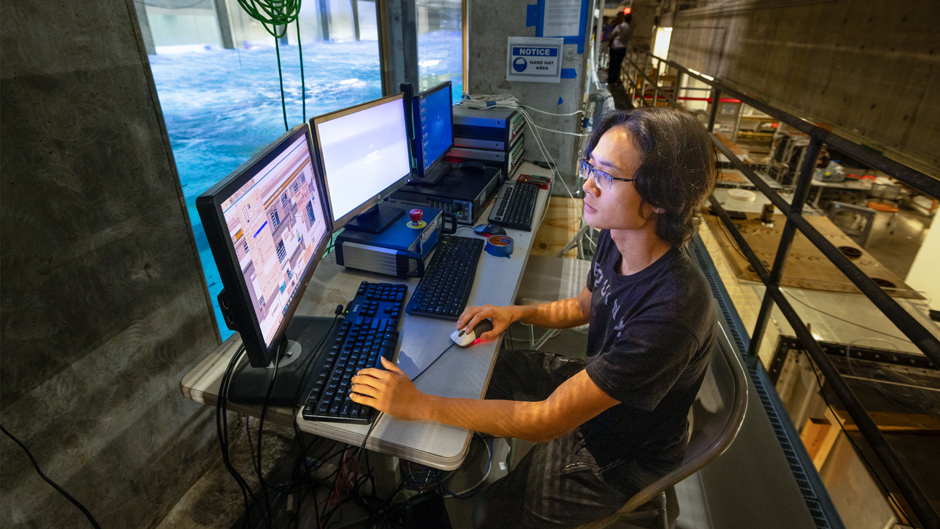Peisen Tan turned tragedy into a teaching moment.
When Typhoon Lekima lashed parts of his home country of China 11 years ago, killing more than 70 people and causing billions of dollars in damage, he reaffirmed his commitment to study physical oceanography to help coastal communities better prepare for storms.
Today, Tan is making good on that pledge.
As a Ph.D. student at the University of Miami Rosenstiel School of Marine, Atmospheric, and Earth Science, he is conducting cutting-edge research on air-sea interactions, using the powerful Alfred C. Glassell Jr. SUrge-STructure-Atmosphere INteraction (SUSTAIN) Laboratory to simulate the way winds power ocean waves.
“Hurricanes whip up devastating waves that can produce huge storm surge conditions that overwhelm coastal areas,” Tan said. “Those extreme waves travel great distances. So that’s why wind-wave forecasts, especially under storm conditions, are so vital for coastal communities and for ships at sea. With the simulations we run in SUSTAIN, we’re able to generate data that can be used to improve wave modeling.”
Tan’s research on laboratory experiments with Category 4 hurricane-force winds blown over mechanically generated waves has been published in the Journal of Geophysical Research: Oceans, and the young scientist has other studies planned for publication.
Towering waves powered by tropical cyclones, he noted, not only threaten inland coastal structures; they can also break apart coral reefs, which are already fighting a battle against mass bleaching events caused by warming ocean temperatures.
So as part of his research, Tan has been part of a Rosenstiel School team of scientists that has placed models of coral reefs in the SUSTAIN tank to study how they are impacted by waves.
“But corals can also protect coastlines,” Tan said. As part of a Department of Defense-funded project, he has used SUSTAIN to help investigate the way in which artificial reef structures can mitigate powerful waves and storm surge.
His devotion to studying oceanography began several years ago when, as a youngster, he took up diving and started to notice how climate change is affecting marine life in the world’s oceans. He has explored Australia’s Great Barrier Reef, diving to its deepest depths to gaze at its incredible diversity of life and, sadly, to examine the way mass bleaching events have decimated parts of its ecosystem. And he has probed the coral reefs of the Florida Keys, observing how disease and bleaching have impacted those colonies.
His research, he explained, “would be much more difficult to conduct if I didn’t have the use of a wonderful tool such as SUSTAIN.”
The powerful wind-wave simulator, which turns a decade old this year and can produce Category 5 hurricane conditions, is one of the primary reasons, along with being mentored by noted ocean scientist Brian Haus, that Tan decided to pursue his Ph.D. at the Rosenstiel School. “I was awed beyond belief when I first saw the tank and was amazed at its ability to create any type of hurricane condition we want,” Tan recalled.
He is helping to educate tomorrow’s scientists about the importance of the tank and hurricane research, conducting tours of the SUSTAIN Laboratory for elementary, middle, and high school students.
“Every experiment we run in SUSTAIN is for a safer tomorrow,” Tan said, “not only for communities but also for marine life.”

